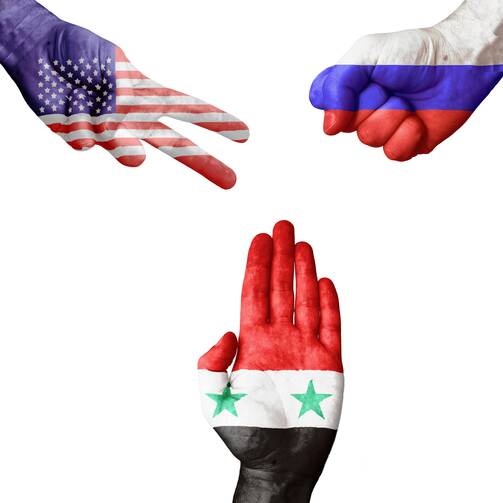The Great Powers in Syria
The entrance of the Russian Federation into Syria’s multi-front civil war begins a new, distressing chapter in the savage conflict. As millions flee and others huddle in ruined cities, anyone who has wondered if the Syrian war could possibly get any worse now has an answer.
Despite tough talk on the Islamic State, Russian forces have concentrated on anti-Assad rebel targets. In return U.S. restraint on weapons transfers to the Free Syrian Army and allied militias has abruptly lifted. The conflict now shows all the initial makings of a new proxy war between the great powers. At least the Russian aim in Syria is clear: salvage the Assad regime and protect strategic assets. But what exactly is the goal of the continuing U.S. intervention in Syria? The Obama administration properly abandoned a $500 million program aimed at training a perhaps more-wished-for-than-real “moderate” resistance to President Assad. Now going tit-for-tat with the Russians begins a new adventure that is hideously indifferent to the suffering of the Syrian people and the possibility of an accidental (or otherwise) encounter between U.S. and Russian forces.
The administration should be redirecting its energy and resources into promoting a U.N.-mediated cease-fire negotiation between the diminished Assad regime and whatever real moderates the Obama administration can drag into dialogue. Even a brief respite from the mayhem might give all parties a chance to remember what they have lost in this war and to consider if other means might achieve something close to their goals. Syria will never be the nation it was, but anything is better than perpetuating another moment of the combat zone it has become.
Offering Healing and Hope
October was Domestic Violence Awareness Month, and the National Council of Catholic Women wanted to make sure that the occasion did not pass unnoticed. The organization issued a 52-page resource manual on preventing domestic violence, with the hope that it will inform people about the prevalence and impact of domestic violence, as well as the church’s response, prayers and other resources. They also created a customizable safety flyer that can be posted in public locations. (Both are available at nccw.org.)
According to the Centers for Disease Control and Prevention’s National Intimate Partner and Sexual Violence Survey, “more than one in three women (35.6 percent) and more than one in four men (28.5 percent) in the United States have experienced rape, physical violence, and/or stalking by an intimate partner in their lifetime.” The 2002 U.S. bishops’ pastoral letter in response to the issue of domestic violence sought to remind those being abused that the church should be a help, not a hindrance to them: “As a resource, it [the church] encourages women to resist mistreatment. As a roadblock, its misinterpretation can contribute to the victim’s self-blame and suffering and to the abuser’s rationalizations.”
The N.C.C.W. hopes to ensure that the church is never a hindrance, and its resources can prompt important conversations that can bring difficult subjects into the open and help people to heal. They also remind individuals that neither Scripture nor the church’s teaching on marriage can be used to justify violence in intimate relationships. The effects of domestic violence touch not only women, but families, children, workplaces and parish communities. Though the violence may target individuals, the healing response must come from a caring community.
Innocence Lost
Across Latin America, girls mark their 15th birthday with a quinceañera, a celebration of their transition to womanhood. In El Salvador teens often wear a pink dress on that day as a sign of their innocence, a tradition that belies the harsh realities young people face in one of the world’s most violent countries. A new series from NPR, called “#15girls,” tells their stories. Marcela was shot dead in the street in front of her younger sister. Mimi started helping victims of gangs as a volunteer ambulance worker at age 10. And one girl, unnamed for her protection, traveled 1,000 miles north after her father, a gang member in prison for murder, threatened to have her raped and killed. She was turned back a few hours short of the U.S. border.
El Salvador recently surpassed Honduras as the homicide capital of the world. Over 5,000 people have been killed this year in a country with a population smaller than that of New York City. The mayhem comes amid a crackdown by the government on two warring gangs—MS-13 and Barrio 18—after a truce reached in 2012 broke down last year. According to the World Bank, the country loses 10.8 percent of its gross domestic product each year to crime and violence.
President Salvador Sánchez Cerén has launched a five-year, $2.1 billion plan to strengthen state institutions and help victims of crime. The United States should support these efforts to bring security and opportunity to El Salvador with generous foreign aid. But we should also remember the names and stories behind the “unaccompanied minors” who come to our border seeking refuge.








